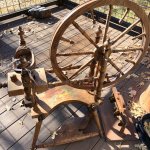Dave Richards
Member
- Messages
- 2,971
- Location
- SE Minnesota
Interesting.
I wonder if I can find that book online.
I wonder if I can find that book online.

Hello, I am curious about the actual wheel that you modeled. You mentioned it being a 1963 model, but do you have any additional information. I know someone who has this exact wheel and is trying to ascertain it's origin.Well, here's another work in progress. This is for a new plan for an old-fashioned spinning wheel. I'm working from information I found from 1963 which turns out to be full of errors so it's slow going. Not sure I've ever done as many "turned" pieces in a single project as in this one. A few parts left at this stage. Waiting for info from an experienced spinner who has a similar wheel.

I think you should build one.
Yes, the names are all wrong for the parts of a spinning wheel. The thing on the far side of the bobbin from the flyer is called the whorl, not the sheaves.I'm not sure where these plans I was working from originate. There are some other odd naming things. In my mind this wheel has only one maiden but it is called maidens. The MoA is called the Main Holder. I did write incorrectly. The distaff is called the Wool Bar and the piece it is leaning against is called the Wool Carrier. The spokes of the wheel are called Toggles and the crank is called Excenter. I expect the person who did the plans isn't a native English speaker and probably also not someone who is into spinning. Probably took an existing unit for measuring and made the plans from it.
I understand the reasoning for the through mortise but at least until I draw threads on the tension knob, I'll leave it like it is so the lack of threads doesn't show.
The Amos book has a lot of information on processing the fiber and it's an expensive book. However, there is the book about Canadian spinning wheels, which covers a lot of technical aspects and that is available for $16 as an ebook from the University of Ottawa Press.She said that "castle wheels have the flyer above the wheel", although there is a lot of variance on that concept..
One of the better technical books on relative dimensions and usages is "alden amos, big book of handspinning" - he had a rather wry sense of humor though so you have to read it with a bit of an eye towards when he was tongue in cheek.
You can get 'Selected Canadian spinning wheels in perspective' as an e-book for $16 from the University of Ottawa Press and it is specific wheels, rather than adding in the fiber stuff in the Amos book. The Amos book is out of print and pretty pricey as a result.Interesting.
I wonder if I can find that book online.
In most wheels, the turnings on the whorl (sheaves) side maiden are trimmed back to allow the whorl to sit closer to the leather bearing. Definitely looks like the width of the mother-of-all and positions for the maidens are a bit wonky. It isn't unusual for the uprights that support the wheel to be tilted or even offset slightly to tip the wheel a bit towards the right in this view, allowing the MOA to not have to ride out so far to the left. The flyer design shown is also peculiar - usually they are more of an open horseshoe shape.Hey Ryan. No. We don't count hand planes or, in this house, bikes, apparently.
I do have a question you might be able to answer. I've modeled the "mother of all" as per the old article but I'm thinking it must be wrong. In order to get the flyer, bobbin, and the two sheaves to fit and get the sheaves close to lined up with the wheel, I ended up shortening the bobbin so the winding part is less than 3 in. long and I had to cut a good 3/4 in. off the horns of the flyer. The bobbin is supposed to be 4-3/8 long plus the mushroomed head. I also had to extend the leathers that assembly fits on so the assembly is quite a way out in front of the maidens. Could you give me some rough ideas about dimensions on the mother of all? I think I need to move the maiden next to the sheaves over a bit and add even more on the orifice side so I can stretch the bobbin and flyer back out and slide things back away from the wheel a bit.

